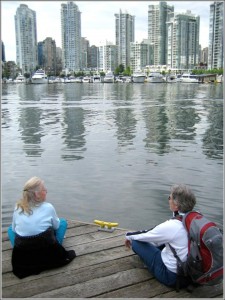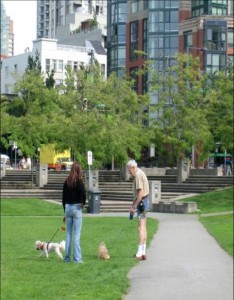
There’s a lot of talk around in “sustainability” circles about the need for sustainable communities to have higher density housing and Transit-Oriented Development (TOD).
But what works and what doesn’t work?
A recent study of high-rise, high-density housing in central Vancouver provides lots of answers.
It was conducted in 2007 and 2008 in Vancouver’s large downtown redevelopment area, False Creek North, by postgraduate students of the School of Community and Regional Planning at the University of British Columbia.
The research was directed by Wendy Sarkissian and Larry Beasley.
The Research Manager was Nancy Hofer.
Many methods were used, from community engagement approaches to a formal questionnaire survey of householders. It’s probably the largest study of this sort conducted in the world in recent years, with a sample of 4000 and a response rate for the mail-back questionnaire survey of 12.5 percent.
The project is now complete and all findings have been published.
Vancouver consistently ranks high (or highest) in international rankings of liveability. For the fifth straight year, Vancouver was named the most liveable city in the world by the Economist Intelligence Unit in 2011.
Having been raised in Vancouver, I’ve always been fascinated by its popularity. Growing up in a low-income family, I guess I missed some of the features the planners and evaluators value. And I often wondered if they counted the yearly quotient of 265 days of rain in their evaluations.
So it was with great excitement that I found myself in 2007 evaluating housing in Vancouver from the residents’ perspective. After 44 years, I was coming back to my home city — and studying it.
January 2007 saw the beginning of an intensive project that fulfilled many of my dreams as an educator and researcher.
With Larry Beasley CM, formerly Co-Director of Planning for the City of Vancouver, I taught and co-managed a three-term intensive subject and collaborative research project as Adjunct Professor in the School of Community and Regional Planning (SCARP) at the University of British Columbia (see www.scarp.ubc.ca).
The topic of the research is “Understanding Vancouver’s Inner City Housing: An Adventure in Multifaceted Post-Occupancy Evaluation.” In the first term, fifteen students developed methods to be used to evaluate housing in Vancouver’s inner city False Creek North neighbourhoods.
My participation in this project was generously funded by two Vancouver developers: Concord Pacific Developments and Steve Hynes of Hynes Developments, assisted by Larry Beasley.
- Dogs are an issue in False Creek North
Summer intensive on the public realm
A highly successful summer intensive in Vancouver in June 2007 focused on the parks, plazas, playgrounds and other public spaces in False Creek North, as well as lessons learned from the earlier development of False Creek South.
In this work, I was assisted by several generous colleagues, including planner and criminologist, Gregory Saville, of Alternation Consulting (www.alternation.ca).
Other lecturers included post-occupancy evaluation specialist, Professor Jacqueline Vischer, formerly Professeure titulaire, Groupe de recherche sur les environnements de travail at the University of Montr©al,Vancouver-based architect-planner David Ellis and Pieter Rutgers of the Vancouver Board of Parks and Recreation (see www.vancouver.ca/parks).
In the third term, which began in September 2007, my students began conducting detailed observations and questionnare-based evaluations of components of the housing developments.
Some students undertook major projects and theses in a subsequent term.
This research continued throughout 2008.
REPORTS ON THE POST-OCCUPANCY STUDY
Please contact me on [email protected] for the full reports.
Here is a brief summary report:
False Creek North POE Recommendations for Designers and Developers
… and the full report:
… False Creek North POE Compilation Full Report
… and a short report:
False Creek North POE Short report
For an excellent summary, go to:
https://pricetags.files.wordpress.com/2012/05/price-tags-104.pdf
We have detailed findings about households, families, tenure mix, housing satisfaction, the public realm, retail development, children’s play, parks, community safety, building design and unit design”¦
Speaking about the POE”¦
I am available to speak about the research and the findings to community groups, developers, planners and people in government.
April 2011: Some current thoughts
It has recently been announced that Vancouver – for the fifth year in a row – has been voted the most liveable city in the world. Social planners like me find that hard to believe.
There is so much hardship and poverty in Vancouver. Such a huge gap between rich and poor. And did nobody tell the Economist Intelligence Unit that it rains for 265 days a year? Surely that’s a factor!
In March 2011 Brian Hutchinson in the National Post took on the topic. See:
Or
Documents from the Vancouver Post-Occupancy Evaluation (POE) study:
BACKGROUND POWERPOINTS
- CPTED GUIDELINES
- PUBLIC OPEN SPACE AND OLDER PEOPLE
- Housing as if People Mattered for Housing NZ 2005
- Programming Criteria
POWERPOINTS OF LECTURES
- 11 January 2007. Lecture 2.Questions social planners ask FINAL
- 12 January 2007. Lecture 4 POE IntroductionFINAL
- 12 January 2007. Lecture 5. interviewing training UBCFINAL
MATERIAL FROM CLARE COOPER MARCUS
Working Papers on Social Design Issues in High-Density Housing (prepared for Mirvac Fini, Perth, 2003-2004)
- Working paper 5 CPTED final
- Working Paper 6 children in outdoor residential envt
- Working Paper 7 Open Space
- Working Paper 8 older open space
- Working Paper 9 Accessibility for People with a Disability
- Working Paper 10 final HD OLDER
- Working Paper 11 final HD CHILDREN
- Working Paper 12 HEALTHY
- Working Paper 13 HOMEWORKING
- Working Paper 14 CULTURE final
